Deferral events are a common occurrence in email delivery. A deferral event occurs when an email server temporarily refuses to accept an incoming email. It is not a bounce (hard or soft), which reflects the server refusing to deliver the message; rather, it reflects a “not right now” response. As a mail sender, you (or your ESP) may retry delivery later. Many ESPs will automatically retry deferred emails for up to 72 hours.
While easy to overlook, these events often reflect deliverability challenges. They can indicate that your message is not reaching its target audience and left unaddressed they risk growing like an unchecked virus, infecting all of your email delivery efforts.
If your email is deferred – that means your reader isn’t seeing the message when you want them to. If it has time sensitive information (an expiring offer?), this can be bad – for both you and the recipient, as neither of you are able to realize the benefit of the offer.
Causes
There are legitimate reasons why a mail server might defer a delivery – maintenance or insufficient capacity due to a spike in mail volume, for example.
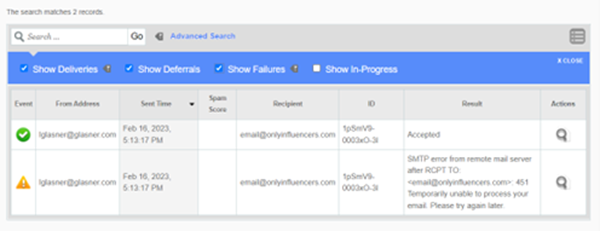
In this case, we see two different events for the same email attempt. The first reflects a deferral (“Temporarily unable to process your email”), followed immediately by a successful delivery. This type of pattern almost certainly hints at a temporary problem with the mail server, which had resolved itself within moments. These types of sporadic deferral issues are unlikely to indicate a problem with your mail campaigns. The decision to retry immediately was based on configuration of the mail sending server. Most ESPs will introduce a delay of minutes or hours in between retry.
From larger email providers, such as Gmail, deferrals are unlikely to reflect a temporary capacity or technical issue. They are more likely telling you that they don’t want to deliver your email right now – because there is something about it that they don’t like or trust. This may be, for example, due to a surge of delivery from a brand new IP or domain, or a large number of spam complaints. Detecting and responding to these types of deferrals can be critical to the health of your email campaigns.
Example
A client had an email campaign reporting successful delivery to approximately 70,000 addresses. However, the engagement rates were far lower than anticipated. Upon exploring further, the deferral rate began to rear its head. Figure 1 shows a breakdown of events received for the campaign:
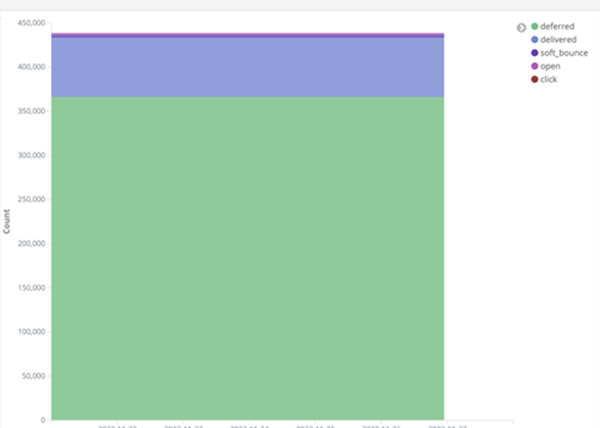
Yes, that’s right. For a 70,000 email campaign, over 350,000 deferral events were reported.
Figure 2 shows the breakdown of events by mail provider:
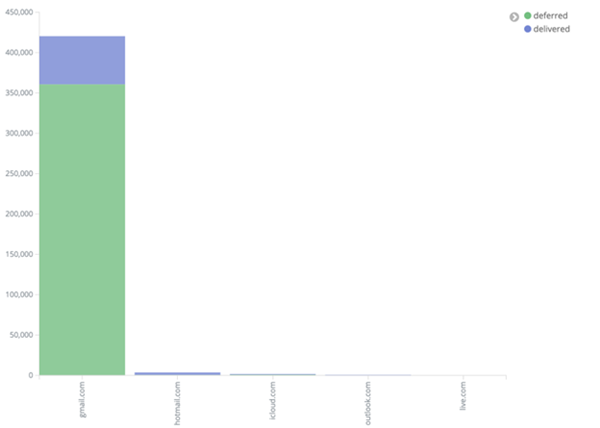
This breakdown reflects that the composition of the list (nearly 90% of the addresses are gmail) is highly correlated with the deferral events (nearly 100% of the deferral events came from Gmail). For each email received, Gmail is deferring it an average of 6 times. The rate of retry will be dependent on your ESP, but this can reflect that the actual email delivery may be many hours – or more.
But recall: the overall delivery rates were in line with expectations. These emails were eventually delivered, just not when the client expected, and most likely did not receive the inbox treatment the client wanted.
Gmail did not like this email campaign
A deferral event from a provider such as Gmail is a signal that there is something wrong with your campaign, and Gmail is telling you to fix it. When Gmail eventually does accept and deliver your email, it is likely going to the spam folder anyway, where your customer is unlikely to see it.
So what do you do next? Figure out why the provider doesn’t like the email. How you approach this depends on the provider. For Gmail, a great first place to look is the Gmail Postmaster Tool. And sure enough, Figure 3 shows the answer:
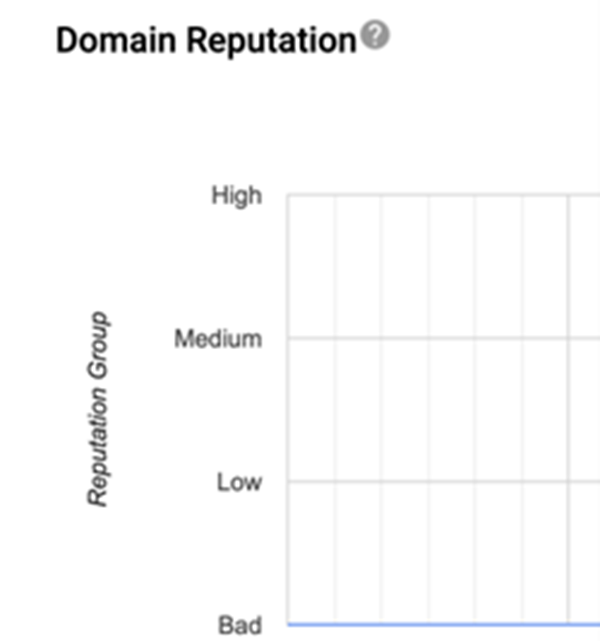
Gmail does not like the sending domain. With that information in hand, we were prepared to help the client run a test to confirm that was the problem. For the next campaign, the client sent using a different domain that they verified had a high reputation. Figure 4 shows the results:
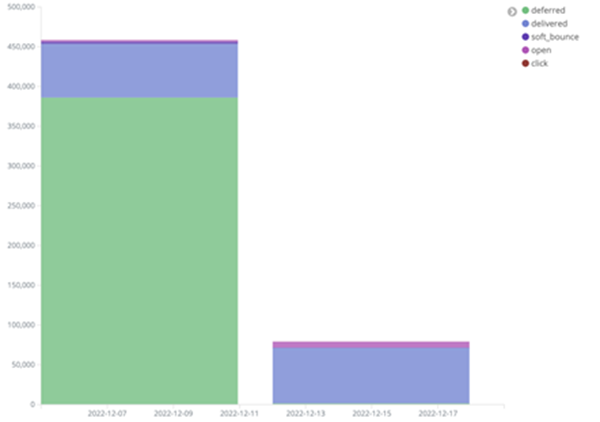
Sent from a trusted domain, the deferral rates disappeared. The engagement rates on the resulting email went up, in line with the clients expectation.
Conclusion
In conclusion, deferral events are a signal of a problem with your email campaign. Not only do they reflect a delay in your readers getting to the information you want, they can reflect a mail provider’s reflection of the quality of your email delivery. Left unchecked, they risk creation of a downward spiral – where poor engagement leads to more deferrals and worse engagement. Fortunately, deferral events can be easy to find in your ESP messages, and several tools are available to help start the investigative process to better understand how you can respond.
NOTE: The approach used in this test (changing to a new domain) reflects only an approach to verify the problem, not a long term solution. I do not recommend changing your sending domain to attempt solving the problem. If your mail strategy has led to a poor domain reputation, doing the same thing again will lead to the same result. This approach can be used to verify a problem, but appropriate longer term steps need to be taken to permanently solve the problem.
Paul will lead a conversation on this post during the March 16, 2023 OI-Members-Only Live Zoom Discussion (12:00 Noon to 1:00 PM ET). OI Members watch your email for an invite. Not a member? Join today! Just $200/year to network with and learn from your fellow email industry professionals. Or request a guest invite from Jeanne Jennings, General Manager of OI.

Photo by Erik Mclean on Unsplash
